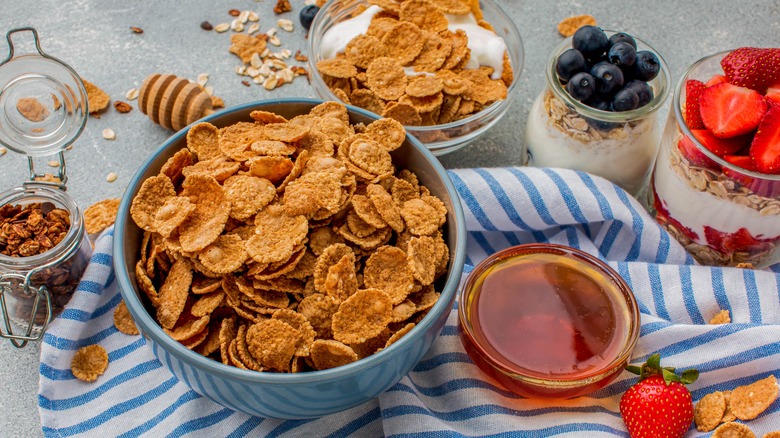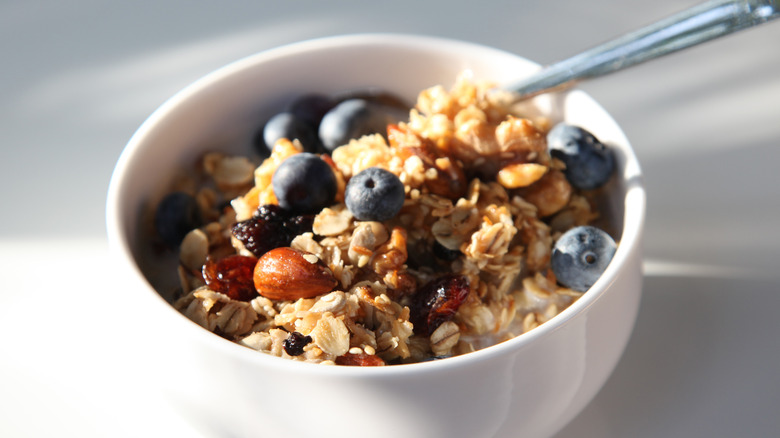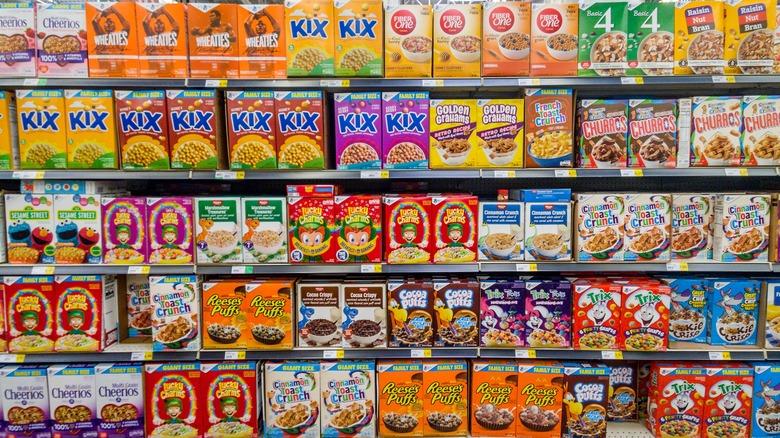The Interesting History Of How Cereal Became A Breakfast Staple
Today, cereal seems so simple, but it wasn't always associated with colorful boxes and breakfast time. Before it was everyone's favorite morning fuel, it was a sugarless digestive aid that kids probably wouldn't touch with a 10-foot pole. Much like the rise of New York's breakfast sandwiches and other hand-held meals, cereal became a parents' favorite for its five seconds of prep work: pour cereal, pour milk, and voila, breakfast. Once companies saw the appeal for busy parents, they decided to get the youngsters on their side. Through fun gimmicks, free prizes, and cartoon mascots, cereal brands did their best to get kids sneaking boxes into the shopping cart.
Cereal's earth-shattering combination – some sort of sugary grain and milk – left room for endless experimentation. The new food product introduced dozens of flashy labels and beloved characters like Kellogg's Tony the Tiger and General Mills' silly Trix rabbit. There's no denying that cereal is tasty, versatile, and easy to prepare, but if it wasn't for bold marketing tactics and its ability to morph with each passing era, would cereal have become the emblem of breakfast that it is today?
We can thank a 19th century doctor for cereal
Before the days of Cap'n Crunch and Lucky Charms, cereal was centered around health and wellness. Noticing the lack of digestive remedies, Dr. James Caleb Jackson came up with a genius solution in 1863, which he termed Granula. Jackson, who ran a sanatorium (which is basically a health spa) in upstate New York, discovered the many health benefits of graham flour and started buying it in bulk. He tried mixing it with water and baking it into large sheets, which he then broke up into tiny pieces and baked again, and discovered a quick and easy way to ease any digestive issues.
The fiber-heavy graham bits were a little tough to chew, so Jackson had the clever idea of mixing the cereal with milk to help wash it down. He then made the mistake of sharing his newfound recipe, and another doctor, John Harvey Kellogg, turned around and stole it for himself. Jackson slapped him with a lawsuit soon after, but Kellogg cleverly swapped one letter, changing his version to Granola. John Harvey was joined by his little brother Will, and together they introduced cereal to the kitchen table, starting with Corn Flakes.
The world's first cereal brand made history
Dr. James Caleb Jackson may have gotten the cereal ball rolling, but it was the Kellogg brothers who developed the first branded box, which they named Corn Flakes. It took some trial and error to lock down the perfect corn recipe for the crunchy cereal, but they ultimately landed on milled kernels of field corn as opposed to graham flour. Before that revelation, the biggest headway was all thanks to a distracted kitchen crew one evening in 1898. The graham flour dough was unintentionally left to ferment, and the Kellogg brothers had a lightbulb moment.
After it had cured a little, they could more easily roll out the dough so the baked pieces were extra thin and crunchy, à la Corn Flakes. After years of ongoing bickering, business trumped family and the two called it quits sometime in the early 1900s. Will bought out his big brother, taking ownership of the cereal, and carried the Kellogg legacy forward. Will clearly had a handle on the exploding cereal market, as his company was cranking out 120,000 cases of Corn Flakes per day by 1909.
Cereal's sugary evolution
Dr. James Caleb Jackson's invention was so incredibly simple, yet revolutionary to breakfast. It didn't take long for brands to jump on the bandwagon, starting with Wheaties in 1921 and soon followed by Chex in the 1930s. As committed as the world was to Kellogg's Corn Flakes, they couldn't resist the temptation of Cheerios – originally Cheerioats — when they rolled out in 1941. To this day, those tasty cereal loops remain America's best selling cereal, with the runner-up being its sweeter counterpart, Honey Nut Cheerios. More and more cereals became household names, and before America knew it, there was an entire grocery store aisle dedicated to the quick breakfast option.
Cereal's rise to popularity wasn't just about its taste, but the marketing strategies behind it. Brands may have sweetened cereal up a bit, but they kept riding the nutritional wave, pushing the rhetoric of breakfast being the most important meal of the day (a sentiment that Alton Brown still agrees with). Kids would devour anything with sugar, and parents were just pleased to see their kids finishing a meal. Before the FDA confirmed the dangers of a sugar-packed diet in 2003, folks just assumed it was the secret to flavoring. Breakfast has gone full circle now, with trends leaning more toward health-conscious morning routines involving açaí bowls and superfoods. Things may look a bit healthier today, but the sugary favorites don't seem to be disappearing any time soon.



